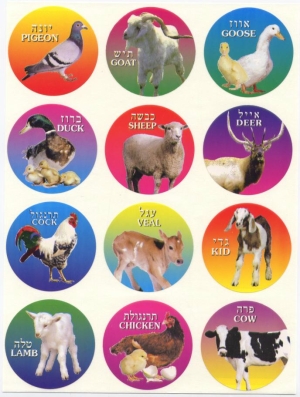FAQ’s Questions about meaning/requirements of Kosher
FAQ
Kosher is there is a difference between the letter of the law and the spirit of the law.
- Question As far as I have found, the letter of the law regarding Kosher requires:
-
- a blade without a nick in it,
- animals can not be less than one week old,
- for Passover sacrificial lamb must be at least one year old, and,
- of course, no pork or shell fish. In addition, animals can’t work on the Sabbath,
- if one is sick or injured, then can, for instance, drive to Vet,
- can’t kill baby in front of mother.
- However, the Talmud also has Tsaar Baaleih Chaim, Compassion for all living creatures, so I would like to know if there are “spirit of the law” parts in Talmud or later Jewish writings that extend more protections for animals.
- For example, industrial raising of chickens put 16 in cage, the birds go crazy and attack themselves, so they cut off their beaks. Fois gras, force feeds geese until their livers burst. To get veal, they put calves in stalls where they can’t move and force feed them milk. Feedlot cows are fed corn and soy which often makes them sick because they are designed to eat grasses. Though Torah only prohibits killing before one week old, are there any later writings that extend the minimum age?
- Are there any writings about the quality of their lives, e.g. allowing free range rather than penned in?
- What I need is a comprehensive list of everything that Judaism says about animals, especially those used for meat.
- I need direct quotes and complete references (where found).
- I am not in a hurry, so if you can find someone willing to help, doesn’t matter if it takes several months.
-
- Answer There are different mitzvahs in the Torah which address different issues. “Kosher” has to do with the species of animal, the way it is slaughtered, and removal of the blood from the meat.
- “Kosher” does not address the issue of conditions in which the animal is raised
- There is another mitzvah, however, which addresses your concern. “Tzar Baalei Chaim” is the Torah prohibition against causing pain to animals. And based on this, the great Rabbi Moshe Feinstein indeed forbade raising animals in cramped and painful conditions.
- As an aside, there are some veal farms who go to great lengths to treat calves in an ethical manner.
Other mitzvahs concerned with the protection of animals include:
-
-
- It is prohibited to cause pain to animals – tzaar ba’alei chaim. (Talmud – Baba Metzia 32b, based on Exodus 23:5)
- One is obligated to relieve an animal’s suffering (i.e. unburden it), even if it belongs to your enemy. (Exodus 23:5)
- If an animal depends on you for sustenance, it is forbidden to eat anything until feeding the animal first. (Talmud – Brachot 40a, based on Deut. 11:15)
- We are commanded to grant our animals a day of rest on Shabbat. (Exodus 20:10)
- It is forbidden to use two different species to pull the same plow, since this is unfair to the weaker animal. (Deut. 22:10)
- It is a mitzvah to send away a mother bird before taking her young. (Deut. 22:7)
- It is forbidden to kill a cow and her calf on the same day. (Leviticus 22:28)
- It is prohibited to sever and eat a limb off a live animal. (Genesis 9:4; this is one of the “Noachide” laws that apply to Jews and non-Jews alike.)
- Shechita (ritual slaughter) must be done with a minimum of pain to the animal. The blade must be meticulously examined to assure the most painless form of death possible. (“Chinuch” 451; “Pri Megadim” – Introduction to Shechita Laws).
- Hunting animals for sport is viewed with serious disapproval by our Sages. (Talmud – Avoda Zara 18b; “Noda BiYehuda” 2-Y.D. 10) Learn More ==> Aish.com
- However?, Shackle-and-hoist is a common method of restraining animals for shechita. In this horrific practice, a slaughterhouse employee places an iron shackle around one of the still-conscious animal’s rear limbs, then hoists the steer into the air where he hangs upside-down by a chain, desperately thrashing and bellowing until slaughter. This cruel method of restraint inflicts broken bones, snapped tendons, and intense pain and stress. In most slaughterhouses, shackle-and-hoist is illegal unless the animals are first rendered insensible to pain. Shamefully, when it comes to ritual slaughter, U.S. law not only permits shackle-and-hoist but also considers it “humane.” This absurd exemption exists despite the fact that the kosher ritual does not require shackle-and-hoist. Many Jewish groups and authorities have even condemned the practice as a violation of tsa’ar ba’alei chaim, the prohibition against causing unnecessary suffering to living creatures.
- Learn More ==> ALDR – Animal Legal Defense Fund.org
- Proposition 12 in California, requires that breeding pigs be confined to a pen with no less than 24 square feet of floor space, allowing them to fully turn around in their living area. The law targeted the practice among some farmers of keeping sows in cramped stalls separate from other pigs. Read More – Los Angeles Times July 2023 *
-
Links & Resources
- Jew FAQ.org
- PETA
- Wiki Pedia – Shechita
- Taz’ar ba’alei chayim
- Aish.com – Animal suffering
- OU.org Tzaar Baalei Chayim
Guaranteed Issue - No Pre X Clause
Quote & Subsidy Calculation
No charge for our complementary services
Watch our 10 minute VIDEO
that explains everything about getting a quote
Video Mouse Experiment on Crowding
Escaping the Laboratory: The Rodent Experiments of John B. Calhoun & Their Cultural Influence
“Behavioral sink” is a term invented by ethologist John B. Calhoun to describe a collapse in behavior which can result from overcrowding. The term and concept derive from a series of over-population experiments Calhoun conducted on Norway rats between 1958 and 1962.[1] In the experiments, Calhoun and his researchers created a series of “rat utopias” – enclosed spaces in which rats were given unlimited access to food and water, enabling unfettered population growth. Calhoun coined the term “behavioral sink” in his February 1, 1962 report in an article titled “Population Density and Social Pathology” in Scientific American[2] on the rat experiment.[3] He would later perform similar experiments on mice, from 1968 to 1972.
Calhoun’s work became used as an animal model of societal collapse, and his study has become a touchstone of urban sociology and psychology in general.[4] Learn More – Wikipedia

